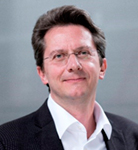
While a large part of humanity benefits from the advantages of solar cells, LEDs and other optoelectronic devices, some scientists are striving to find materials and structures that enable new developments in optoelectronic technologies.
Norbert Koch (Professor at the Humboldt-Universität zu Berlin, and research group leader in that university and at the Helmholtz-Zentrum Berlin) belongs to the latter group of qualified people.
Prof. Koch studied technical physics at the Technische Universität Graz (Austria), where he also did his doctoral studies in solid-state physics. He spent two years as postdoc at Princeton University (USA). In 2003, he started setting up a research group at the Humboldt-Universität zu Berlin, where he was appointed as professor in 2009. His scientific production has more than 16,300 citations and his h-index is 66 (Google Scholar).
This scientist will be in September in Balneário Camboriú (Brazil), giving a plenary lecture at the XVIII B-MRS Meeting. In the talk, he will speak about very promising structures in the field of optoelectronics, which are based on a combination of organic and inorganic materials.
See our mini interview with Professor Norbert Koch.
B-MRS Newsletter: – We´d like to know more about your scientific work. Please choose one or two of your favorite contributions, briefly describe them, and share the references.
All modern optoelectronic devices are complex multilayer structures. To arrive at the desired function, e.g., light emission or energy conversion, with the highest possible efficiency, an optimized alignment of the electronic energy levels is key. For novel and emerging materials, such as organic and 2-dimensional semiconductors, this cannot be achieved readily because the fundamental underlying mechanisms, which govern the level alignment, are not properly understood. Consequently, my research is geared towards unraveling this understanding, and to devise means of optimizing interfacial energy levels. For instance, for a long time it was believed that the level alignment with organic semiconductors is substantially different from what was known for traditional inorganic semiconductors like silicon. The concerted effort of many groups worldwide has finally provided the insight that the established mechanisms do hold, but peculiarities of the organic compounds have to be considered appropriately. It turned out that the energy and density distribution of electronic states of the organic semiconductor critically determines the level alignment, at interfaces towards electrodes [Nat. Commun. 5, 4174 (2014)] and at semiconductor heterostructures [Sci. Adv. 1, e1501127 (2015)]. With this understanding at hand, device engineers can now minimize electrical losses at contacts and precisely tune the energy level offset at heterojunctions.
B-MRS Newsletter: – In your plenary talk at the B-MRS Meeting, you will talk about hybrid (organic / inorganic) structures for optoelectronics. Could you give examples of such structures and their present and/or future applications? Why this type of structure is relevant for developing optoelectronic devices?
The idea to combine inorganic and organic semiconductors is based on the notion to take advantage of the beneficial properties of each component while compensating their respective weaknesses. For instance, inorganic semiconductors typically exhibit high charge carrier mobility and organic ones stand out by very strong light-matter coupling. In a hybrid light emitting diode (LED), one can imagine to electrically pump the inorganic semiconductor at highest levels, and upon energy transfer the desired light is emitted by the organic semiconductor. This could result in LEDs with high brilliance at virtually any color that also feature ultrahigh modulation bandwidth.
For more information on this speaker and the plenary talk he will deliver at the XVIII B-MRS Meeting, click on the speaker’s photo and the title of the lecture here https://www.sbpmat.org.br/18encontro/#lectures.
